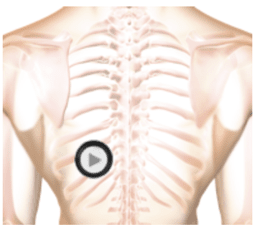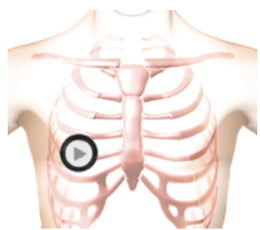Fine vs Coarse Crackles Lung Sounds
Crackles in the Lungs
Welcome to our website's crackles lung sounds page. On this page we provide a definition of crackles, including its clinical significance. We then compare fine and coarse crackles with audio recordings and text. Finally, there is a link to the crackles training lessons available on this site.
Our crackles lessons can be found in this course. Secondly, our reference index is designed to provide quick access to stridor sounds, with audio tracks, listening guides and waveforms. Use this link for quick reference to heart and lung sounds.
Listen To Fine vs Coarse Crackles
Fine Crackles Audio
Listen to these fine crackles. The sound is like salt added to a hot pan.


The patient was seated during auscultation.
Coarse Crackles Audio
These coarse crackles are lower in pitch and have increased volume intensity. Often they have longer duration.


The patient was seated during auscultation.
Respiratory Sounds Reference Guide
Our auscultation reference guide provides quick access to this sound as well as many other adventitious sounds. Each sound is described also with an audio recording and waveform.Quick Links to Other Breath Sounds
While we have many breath sound lessons and quick references on this website. Please use the links below.
Bronchial Breath Sounds
Adventitious Breath Sounds
Adventitious Lung Sounds
Wheezing
Rhonchi
Fine and Coarse Crackles
Rales
Egophony
Auscultation Lung Sounds Audio
Related Lessons
| Basics of Lung Sounds
The goal of this basic course in lung sounds is to improve auscultation observational skills. We focus on describing important breath sounds and in providing recordings of each. Many students find that waveform tracings aid in learning lung sounds; we have included dynamic (moving cursor) waveforms with each lesson. The anatomy pages use illustrations to reveal an example of each lung sound (anatomy not yet available on smartphones). |
| 1 | Vesicular - Normal |
| 2 | Crackles - Fine (Rales) |
| 3 | Crackles - Coarse (Rales) |
| 4 | Wheeze |
| 5 | Rhonchi - Low Pitched Wheezes |
| 6 | Bronchial |
| 7 | Pleural Rubs |
| 8 | Bronchovesicular |
| Intermediate Lung Sounds
The goal of this intermediate course is to expand your observational skills when auscultating breath sounds. The course lessons include voiced sounds: bronchophony, egophony and whispered pectoriloquy. We also provide auscultation lessons on several types of wheezes, crackles and stridor. Each of these lung sound lessons includes audio, text and dynamic waveform. The anatomy pages use illustrations to reveal an example of each lung sound (anatomy not yet available on smartphones). |
| 1 | Vesicular - Diminished |
| 2 | Bronchophony - Healthy |
| 3 | Bronchophony - Abnormal |
| 4 | Egophony - e |
| 5 | Egophony - a |
| 6 | Whispered Pectoriloquy - Healthy |
| 7 | Whispered Pectoriloquy - Abnormal |
| 8 | Wheeze - Expiratory |
| 9 | Wheeze - Monophonic |
| 10 | Wheeze - Polyphonic |
| 11 | Crackles - Early Inspiratory (Rales) |
| 12 | Crackles - Late Inspiratory (Rales) |
| 13 | Stridor |
Authors and Reviewers
Authored by Diane Wrigley, PAMedically reviewed by Dr. Barbara Erickson, PhD, RN, CCRN.